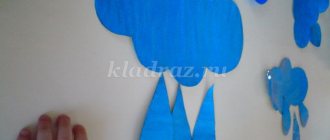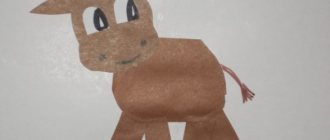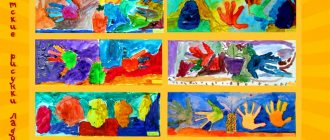Nazilya Khismatullina
Thematic applique with drawing elements “Visiting the Sun”
TASKS:
— Teach children to draw simple plots based on fairy tales.
— Reinforce the technique of cutting round shapes from squares of different sizes.
— To lead to an understanding of the generalized way of depicting different animals (chicken and duckling)
in applique and drawing - based on two circles or ovals of different sizes
(torso and head)
.
— Develop a sense of color, shape and composition.
— Foster independence, confidence, initiative.
MATERIALS, TOOLS, EQUIPMENT:
Sheets of white and blue paper for the background, yellow or orange paper squares of different sizes: the largest for the sun, medium-sized for the body of a duckling and chicken, the smallest for the head (thus, each child should have a set of one large , two medium and two small squares); scissors, glue, glue brushes, colored pencils and markers, paper and cloth napkins. Two or three versions of the composition “ Visiting the Sun ”
for showing to children.
Channel One visited the most famous hermit in the world, Agafya Lykova
One of the most famous hermits in the world is Agafya Lykova. Her life is followed with interest both in Russia and abroad. And now there is news. The First Channel film crew went on an expedition to find out what is happening in the taiga outback.
By the age of 77, the famous hermit Agafya Lykova seemed to have become part of the taiga, like the air or water of her native river Erinat. Because of the strict rules of the Old Believers, it is as if you are stepping back in time. Only with the help of flint is it possible to create fire. Treat yourself with a taiga first aid kit. For decoctions - dried lingonberries, plantain, rowan. Chaga is a tree mushroom - the hermit considers it a cure for all diseases.
At her age, Agafya Lykova gives a head start to guests from the mainland. For hundreds of kilometers there is not a soul - almost.
— Once the bear stood. - Right here? - Right here. - Can he come out now? - Hungry. Sometimes he walks all winter.
At the end of the 70s, there were no camera traps—the forests in the south of Khakassia were explored by groups of scientists. A real sensation then was the discovery of a family of hermits and Old Believers, the Lykovs, who, hiding from religious persecution, lived for half a century in complete isolation from the outside world. They ate fish, nuts, grew potatoes and even baked bread with them.
“They pounded barley straw and birch bark. Everything is there. Turnips, radishes, chaff and potato leaves, these are the tops. Complete hunger,” says the hermit.
As a result, it was not hunger, but diseases brought from the mainland that killed almost the entire family.
"One. I’ll be 34 years old today, and I’m already alone here,” says Agafya Lykova.
At the entrance to the hermit’s hut there is a warning: “Do not enter this house without my permission and do not take any census.”
News from civilization rarely reaches here. The drone camera scares the hermit at first, but curiosity wins out. In order to stay in touch with priests and volunteers, the hermit agreed to accept a donation of a satellite phone and a solar battery for charging, which were brought by employees of Oleg Deripaska’s “Volnoe Delo” foundation. Before this, Agafya Lykova asked the industrialist to build her a new house - the hut was completely worn out.
“The house was built first in Abakan, it was erected, all the logs were numbered, dismantled and floated down the Abakan River by airboats. In total, there were about 38 trips along the river,” says Ruben Bunyatyan, representative of the press service of the Volnoe Delo Foundation.
Agafya repeatedly had the opportunity to return to live with people - she had distant relatives and was invited to an Old Believer monastery, but she still chose loneliness every time.
- There’s nothing to breathe there. Cars are generally scary. - And the doctors? — There are icons on the shrine over there. They are doctors.
In the new house, stones with patterns are laid out - the main toys of the hermit’s childhood, which she shares at parting. The main thing that Agafya takes away from such meetings is simple human communication, which she still lacks. And even though the outside world is foreign and unknown, she continues to pray for him every day.
- I pray for everyone. From prayer the Lord gives health and help.
MAGAZINE Preschooler.RF
Summary of a lesson on application in the middle group “And the Sun has clear rays”Prepared by teacher Yakovleva E.S. 2022 Municipal budgetary preschool educational institution "Shemurshinsky kindergarten "Romashka"
Program content:
Educational objectives: learn to create an image - a symbol of the Chuvash pattern depicting the sun, arranging the elements of the pattern and gluing them to the base.
Developmental tasks: develop children’s ability to place shapes throughout the sheet, as well as the ability to compose a simple pattern of geometric shapes on a square; develop aesthetic taste.
Educational objectives: to cultivate interest and emotional responsiveness to the means of artistic expression of works of Chuvash applied art.
Vocabulary work:
Activate children's vocabulary with words: rays, sun, pattern.
Methods and techniques:
- A surprise moment - the Ilembi doll invited the children to visit.
- Examination of the pattern on the doll's dress.
- Questions:
-What does the pattern look like?
— Does the pattern look like a sun?
- What does the sun have?
4. Game “Sun Rays” (children lay out rays on the floor from satin ribbons to the model of the sun).
5. Making napkins for the doll’s girlfriends.
6. Demonstration of a sample method of action.
7. Laying out the pattern details on the prepared square.
8. Physical school.
9. Encouraging children.
10. Instruction, reminder.
11. Examination of symbol patterns on a multimedia installation
12. Outdoor game “Sun and Rain”
Preliminary work:
- Drawing the sun
- Learning the outdoor game “Sunshine and Rain”
- Learning physical education
Material and equipment
- Doll in national costume
- Fine model of the original pattern (symbol of the sun)
- Napkin with a pattern.
- Cards with drawings of patterns and their semantic meaning.
- Hoop covered with fabric.
- Colored ribbons.
- Attributes for an outdoor game (sun and cloud)
- Handout: red cardboard 15*15 cm, yellow and green pattern elements 2 pieces each, glue, napkins.
Progress of the lesson:
Educator: Guys, we have guests today, say hello! (Children say hello). Now come to me and see who is waiting for us? This is a doll. Her name is Ilembi. Let's come closer and see how elegant she is. Guys, the doll has a beautiful dress, and unusual patterns are embroidered on it.
Children look at the doll and the patterns on the dress.
Educator: What does this pattern look like? (children's answers). Well done! And it seems to me that this pattern resembles the sun. The sun has rays and this pattern also has rays. The rays look in different directions to keep everyone warm. Does this pattern look like the sun?
Children: Yes!
Educator: Guys, Ilembi is telling us something. Ah-ah-ah, I understand. She reminded me of an interesting game. Now you and I will play it, and the doll will sit next to you and watch.
Educator: I have a circle. Now we will make a sun out of it. Look how big the circle is (puts it on the floor). There is a circle, but what is missing?
Children: Luchikov.
Educator: That's right, the sun doesn't have enough rays. We will make rays from ribbons. Our doll has these ribbons. Look, here they are (takes out colored ribbons that are on a tray and shows them to the children). We will lay out the rays like this: first we will lay out a yellow ray, then a green one, then again a yellow one, and so on until we have laid out all the rays; Our rays are straight (shows how to lay out ribbons on the floor). Come to me, I will give you ribbons (hands out ribbons to children).
The game "Sunshine"
(children lay out rays from colored ribbons on the floor).
Educator: Look what a beautiful sun we have created! Well done! Now, guys, help me clean everything up (children help clean up the attributes). Our doll has a beautiful scarf! (Takes out a napkin that is located on the doll’s apron.) Look.
Children look at the napkin.
Educator: There is a sun on this napkin. And he has rays. The rays are colored, on a napkin they are located one after another. Our doll has girlfriends, but they don’t have such beautiful scarves. Can we help the doll make handkerchiefs?
Children: Yes!
Educator: Sit down at the tables, guys. Place a handkerchief in front of you, and now arrange the rays on it as on my handkerchief
Sets up an easel on which the sample is placed.
Educator: The rays look in all directions, up and down, right and left. Guys, are the rays different colors or the same? (Children's answers). That's right, rays of different colors. And on our handkerchiefs we will arrange the colors in order: yellow, green, yellow, green.
Children lay out the details of the pattern on their blanks.
Educator: Spread out? Well done! Now let's play. Stand near your chairs.
Physical school is being held.
Guys, let's call the sun!
Sunny, little bucket, (they wave their hands invitingly)
Look out the window! (one hand above the head, the other under the chin - depict a window)
Your kids are crying (pretending to cry)
They jump on the pebbles. (jump up)
Educator: We played, now sit down at the tables, let’s glue our rays. First, take the top yellow ray, turn it over, and spread it with thin glue. Spread glue over the entire ray; Carefully, evenly place the ray in its place, pressing it with a napkin. Then we take the green ray, then the yellow one, and now the green one again. Glued? Well done!
Educator: Take your tissues and leave the tables. Look how many beautiful scarves you have made. Give them to Ilembi doll so she can give them to her friends. How happy the doll is. We have the sun on our scarves and the sun on our dress.
Children place their work on the high chair where the doll is located.
Educator: Look at this big screen, everyone.
Displaying illustrations of patterns-images on a multimedia installation
Educator: What do you see on the screen? That's right, it's a tree, and this is how you can show a tree on a handkerchief. This is a pattern. This is a house, and this could be a house on a handkerchief. This is also a pattern. Say in unison: pattern.
Children (in chorus): Pattern.
Educator: Well done! Patterns may vary. Next time we will make other patterns on handkerchiefs. Guys, the sun has come through our window. Here it is (takes out attributes for the game).
The outdoor game “Sunshine and Rain” .
Educator: Did you like making handkerchiefs today? Did they turn out beautiful? Next time we will make other patterns on handkerchiefs? Say goodbye to the doll and the guests.
The children say goodbye and leave.
| Next > |





